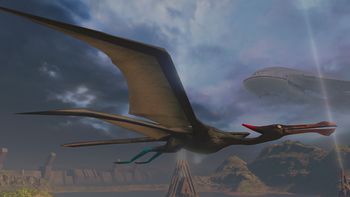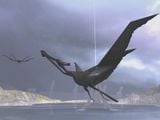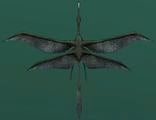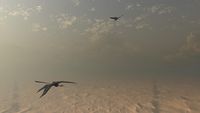Rangmejo: Difference between revisions
From Halopedia, the Halo wiki
No edit summary |
No edit summary |
||
| Line 1: | Line 1: | ||
{{Title|''Rangmejo''}} | {{Title|''Rangmejo''}} | ||
{{Era|Forerunner|HCW|Post}} | {{Era|Forerunner|HCW|Post}} | ||
[[File:H2A Rangmejo.jpg|thumb|right|350px| | [[File:H2A Rangmejo.jpg|thumb|right|350px|''Rangmejo'' superficially resemble ''[[Wikipedia:Pteranodon|Pteranodon]]'' species, despite having a total of six limbs and long tails.<ref name="CF38"/><ref name="HHITD15"/>]] | ||
'''''Rangmejo''''' (as they were known to [[Forerunner]] [[Lifeworker]]s), or "'''quadwings'''", are a species of large [[Wikipedia:Pterosaur|pterosaur]]-like creatures with dual sets of wings.<ref name="CF38"/> They are among the most ubiquitous varieties of fauna that have been encountered on Forerunner installations by the [[United Nations Space Command]], as they have been observed on [[Installation 00]] and multiple [[Halo ring]]s.<ref name="CF38"/><ref name="HHITD15"/><ref name="H2DH"/> ''Rangmejo'' have been known to gather in significant numbers within artificially-constructed chambers.<ref name="HHITD15"/> | |||
==History== | ==History== | ||
| Line 12: | Line 12: | ||
''Rangmejo'' are large creatures with two sets of impressive wings flanking a narrow, muscular body.<ref name="CF38"/> At one end of that body is a head featuring a strong, lengthy beak and a protruding crest—often brightly colored. At the other is a long tail that can represent over half of the length of the individual's body.<ref name="CF38"/> Their considerable size is matched by their two large wingspans, the wings of which flap and beat heavily.<ref name="HHITD15"/> ''Rangmejo'' somewhat resemble ''[[Wikipedia:Pteranodon|Pteranodon]]'' species, thanks to their prominent head crests.<ref name="HHITD15"/><ref name="H2DH"/> The specimens acquired by the UNSC show remarkable evidence of [[Wikipedia:Optimality model|genetic optimization]], their ancestors having been specially adapted by Forerunner [[Lifeworker]]s.<ref name="CF38"/> ''Rangmejo'' have been noted to make a squealing sound while flocking together in large numbers.<ref name="HHITD15"/> | ''Rangmejo'' are large creatures with two sets of impressive wings flanking a narrow, muscular body.<ref name="CF38"/> At one end of that body is a head featuring a strong, lengthy beak and a protruding crest—often brightly colored. At the other is a long tail that can represent over half of the length of the individual's body.<ref name="CF38"/> Their considerable size is matched by their two large wingspans, the wings of which flap and beat heavily.<ref name="HHITD15"/> ''Rangmejo'' somewhat resemble ''[[Wikipedia:Pteranodon|Pteranodon]]'' species, thanks to their prominent head crests.<ref name="HHITD15"/><ref name="H2DH"/> The specimens acquired by the UNSC show remarkable evidence of [[Wikipedia:Optimality model|genetic optimization]], their ancestors having been specially adapted by Forerunner [[Lifeworker]]s.<ref name="CF38"/> ''Rangmejo'' have been noted to make a squealing sound while flocking together in large numbers.<ref name="HHITD15"/> | ||
== | ==Behind the scenes== | ||
{{Linkbox|gallery=yes|gallerypage=Images of Quadwing}} | {{Linkbox|gallery=yes|gallerypage=Images of Quadwing}} | ||
*Quadwings appear in the ''Halo 2'' campaign levels [[Delta Halo (level)|Delta Halo]] and [[Regret (level)|Regret]]. In ''Halo 3'', they can be found in the multiplayer levels [[Guardian (level)|Guardian]] and [[Epitaph]]. | *Quadwings appear in the ''Halo 2'' campaign levels [[Delta Halo (level)|Delta Halo]] and [[Regret (level)|Regret]]. In ''Halo 3'', they can be found in the multiplayer levels [[Guardian (level)|Guardian]] and [[Epitaph]]. | ||
Revision as of 12:23, July 16, 2019

Rangmejo (as they were known to Forerunner Lifeworkers), or "quadwings", are a species of large pterosaur-like creatures with dual sets of wings.[1] They are among the most ubiquitous varieties of fauna that have been encountered on Forerunner installations by the United Nations Space Command, as they have been observed on Installation 00 and multiple Halo rings.[1][2][3] Rangmejo have been known to gather in significant numbers within artificially-constructed chambers.[2]
History
Rangmejo were among the creatures preserved by the Librarian against the firing of the Halo Array in 97,445 BCE.[4][5] Following this destructive event they were seeded upon at least two Halo rings, installations 03 and 05, while also being left to flourish on the Ark, Installation 00, far beyond the Milky Way galaxy. Rangmejo had been specifically selected and adapted by Lifeworkers to play diverse and important roles within a wide range of ecosystems, helping to contribute to the overall health and stability of various biomes.[1]
In November of 2552 rangmejo were observed by the battling forces of the Covenant and United Nations Space Command when their war brought them to Installation 05.[3] In December of that same year an unfinished Halo ring was fired above the Ark, spelling death for the many sentient creatures which inhabited its surface.[6][7] The Ark's monitor, 000 Tragic Solitude, eventually then began to breed new life forms.[8] Among these were more rangmejo.[2] Following the discovery and subsequent exploration of Installation 03 by humanity in 2552 and 2553, rangmejo were witnessed there.[2] Respected scientist Doctor Luther Mann's observations of those on Gamma Halo made him certain it would not be safe to get close to them.[2]In March of 2555 a small group of humans and Sangheili representing the United Nations Space Command and Swords of Sanghelios, respectively, encountered a large number of the creatures within a dimly lit cavern near the Ark's Foundry. Fortunately for them, the rangmejo left abruptly soon after they were sighted.[2][note 1][9][10] By 2558 the UNSC had procured a few individual specimens for scientific study.[1]
Anatomy, physiology, and behavior
Rangmejo are large creatures with two sets of impressive wings flanking a narrow, muscular body.[1] At one end of that body is a head featuring a strong, lengthy beak and a protruding crest—often brightly colored. At the other is a long tail that can represent over half of the length of the individual's body.[1] Their considerable size is matched by their two large wingspans, the wings of which flap and beat heavily.[2] Rangmejo somewhat resemble Pteranodon species, thanks to their prominent head crests.[2][3] The specimens acquired by the UNSC show remarkable evidence of genetic optimization, their ancestors having been specially adapted by Forerunner Lifeworkers.[1] Rangmejo have been noted to make a squealing sound while flocking together in large numbers.[2]
Behind the scenes

|
Browse more images in this article's gallery page. |
- Quadwings appear in the Halo 2 campaign levels Delta Halo and Regret. In Halo 3, they can be found in the multiplayer levels Guardian and Epitaph.
- Players can shoot these creatures or stick them with Spike Grenades or Plasma Grenades on several Campaign and Multiplayer levels. If shot, they will burst and fall to bloody tatters in mid-air, their gory ribbons tend to just "poof" in the air with few visible body parts falling. Upon death, the quadwing's body disappears for a fraction of a second, then reappears larger than before.
- In Halo Mash-Up: Minecraft Evolved, the Ender Dragon boss mob is retextured to look like a quadwing.
- In response to the increase in questions relating to the quadwing's origins, Frank O'Connor claimed that "They are basically space pigeons, or flying rats. All they do is breed, poop and fly slowly around. Their only known skill is the ability to predict human marksmen and turn just exactly as you were about to shoot them." on an April Fools edition of Halo Waypoint's Canon Fodder blog.[11]
Gallery
List of appearances
- Halo 2 (First appearance)
- Halo 3
- Halo 2: Anniversary
- Halo: Hunters in the Dark
- Halo: Outpost Discovery
Notes
- ^ Halo: Outpost Discovery, a traveling experience canonically set at some point between 2554 and 2557, includes an attraction called "The Ring Experience" which involves viewing a live feed from a QQ-55 Honeybee drone exploring a Halo ring. Multiple rangmejo can be seen in the environment. The planet which the ring is shown orbiting discounts the possibility that it could be Delta or Gamma Halo, and executive producer of The Ring Experience, Jason Ambler, believes it is supposed to be Zeta Halo. If this is the case, the experience cannot be set any earlier than the point in 2555 when the exploration of that installation began. Officially the identity of the installation shown in The Ring Experience is presently undefined by 343 Industries. It should also be noted that the canonical dating of Outpost Discovery may be able to be further narrowed by a display which claims it is believed 343 Guilty Spark was destroyed in 2552. It was in late 2555 that the UNSC first learned of this monitor's survival.
Sources
- ^ a b c d e f g h Halo Waypoint: Cannon Fodder - Jurassic Ark
- ^ a b c d e f g h i j Halo: Hunters in the Dark, Chapter 15
- ^ a b c Halo 2, Delta Halo
- ^ Halo Waypoint: Cannon Fodder - Array With Words
- ^ Halo Waypoint - Librarian
- ^ Halo: Hunters in the Dark, Chapter 1
- ^ Halo Mythos, page 122
- ^ Halo: Hunters in the Dark, Chapter 18
- ^ Halo: Renegades, Chapter 13
- ^ Halo: Outpost Discovery, The Making of The Ring Experience
- ^ Halo Waypoint: Canon Fauxder - Believe







